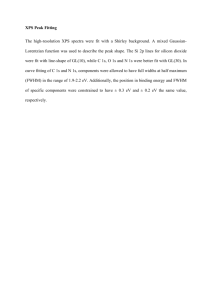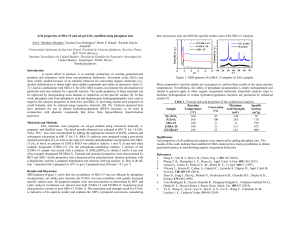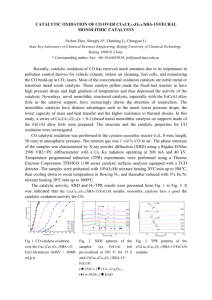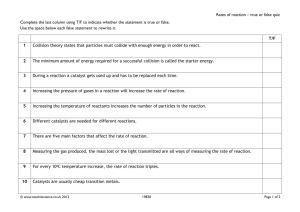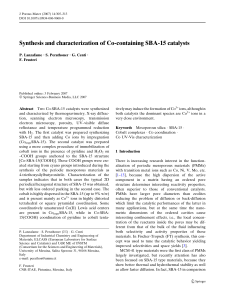Catalytic Partial Oxidation of n
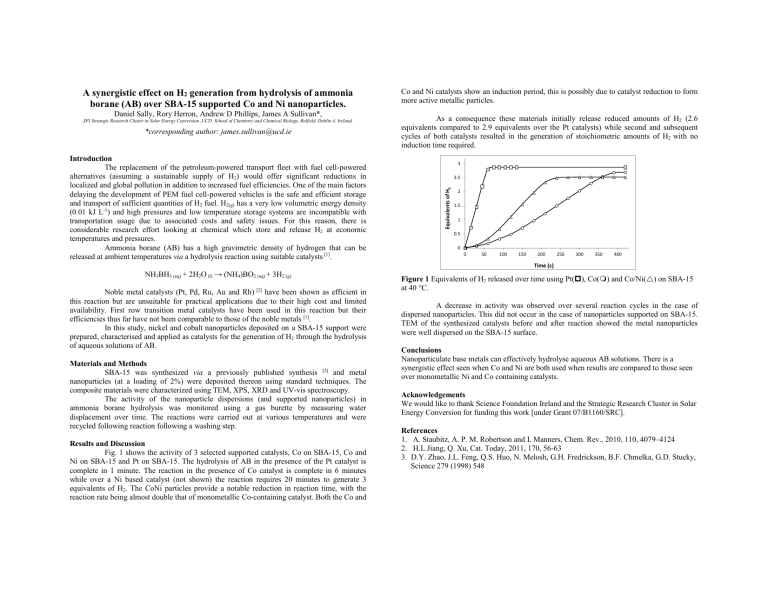
A synergistic effect on H
2
generation from hydrolysis of ammonia borane (AB) over SBA-15 supported Co and Ni nanoparticles.
Daniel Sally, Rory Herron, Andrew D Phillips, James A Sullivan*,
SFI Strategic Research Cluster in Solar Energy Conversion ,UCD School of Chemistry and Chemical Biology, Belfield, Dublin 4, Ireland.
*corresponding author: james.sullivan@ucd.ie
Introduction
The replacement of the petroleum-powered transport fleet with fuel cell-powered alternatives (assuming a sustainable supply of H
2
) would offer significant reductions in localized and global pollution in addition to increased fuel efficiencies. One of the main factors delaying the development of PEM fuel cell-powered vehicles is the safe and efficient storage and transport of sufficient quantities of H
2
fuel. H
2(g)
has a very low volumetric energy density
(0.01 kJ L -1 ) and high pressures and low temperature storage systems are incompatible with transportation usage due to associated costs and safety issues. For this reason, there is considerable research effort looking at chemical which store and release H
2
at economic temperatures and pressures.
Ammonia borane (AB) has a high gravimetric density of hydrogen that can be released at ambient temperatures via a hydrolysis reaction using suitable catalysts
[1]
.
NH
3
BH
3 (aq)
+ 2H
2
O
(l)
→ (NH
4
)BO
2 (aq)
+ 3H
2 (g)
Noble metal catalysts (Pt, Pd, Ru, Au and Rh) [2] have been shown as efficient in this reaction but are unsuitable for practical applications due to their high cost and limited availability. First row transition metal catalysts have been used in this reaction but their efficiencies thus far have not been comparable to those of the noble metals
[1]
.
In this study, nickel and cobalt nanoparticles deposited on a SBA-15 support were prepared, characterised and applied as catalysts for the generation of H
2
through the hydrolysis of aqueous solutions of AB.
Materials and Methods
SBA-15 was synthesized via a previously published synthesis [3] and metal nanoparticles (at a loading of 2%) were deposited thereon using standard techniques. The composite materials were characterized using TEM, XPS, XRD and UV-vis spectroscopy.
The activity of the nanoparticle dispersions (and supported nanoparticles) in ammonia borane hydrolysis was monitored using a gas burette by measuring water displacement over time. The reactions were carried out at various temperatures and were recycled following reaction following a washing step.
Results and Discussion
Fig. 1 shows the activity of 3 selected supported catalysts, Co on SBA-15, Co and
Ni on SBA-15 and Pt on SBA-15. The hydrolysis of AB in the presence of the Pt catalyst is complete in 1 minute. The reaction in the presence of Co catalyst is complete in 6 minutes while over a Ni based catalyst (not shown) the reaction requires 20 minutes to generate 3 equivalents of H
2
. The CoNi particles provide a notable reduction in reaction time, with the reaction rate being almost double that of monometallic Co-containing catalyst. Both the Co and
Co and Ni catalysts show an induction period, this is possibly due to catalyst reduction to form more active metallic particles.
As a consequence these materials initially release reduced amounts of H
2
(2.6 equivalents compared to 2.9 equivalents over the Pt catalysts) while second and subsequent cycles of both catalysts resulted in the generation of stoichiometric amounts of H
2 with no induction time required.
3
2.5
2
1.5
1
0.5
0
0 50 100 150 200 250 300 350 400
Time (s)
Figure 1 Equivalents of H
2
released over time using Pt( ), Co( ) and Co/Ni(
) on SBA-15 at 40 °C.
A decrease in activity was observed over several reaction cycles in the case of dispersed nanoparticles. This did not occur in the case of nanoparticles supported on SBA-15.
TEM of the synthesized catalysts before and after reaction showed the metal nanoparticles were well dispersed on the SBA-15 surface.
Conclusions
Nanoparticulate base metals can effectively hydrolyse aqueous AB solutions. There is a synergistic effect seen when Co and Ni are both used when results are compared to those seen over monometallic Ni and Co containing catalysts.
Acknowledgements
We would like to thank Science Foundation Ireland and the Strategic Research Cluster in Solar
Energy Conversion for funding this work [under Grant 07/B1160/SRC].
References
1. A. Staubitz, A. P. M. Robertson and I. Manners, Chem. Rev., 2010, 110, 4079–4124
2. H.L Jiang, Q. Xu, Cat. Today, 2011, 170, 56-63
3. D.Y. Zhao, J.L. Feng, Q.S. Huo, N. Melosh, G.H. Fredrickson, B.F. Chmelka, G.D. Stucky,
Science 279 (1998) 548
